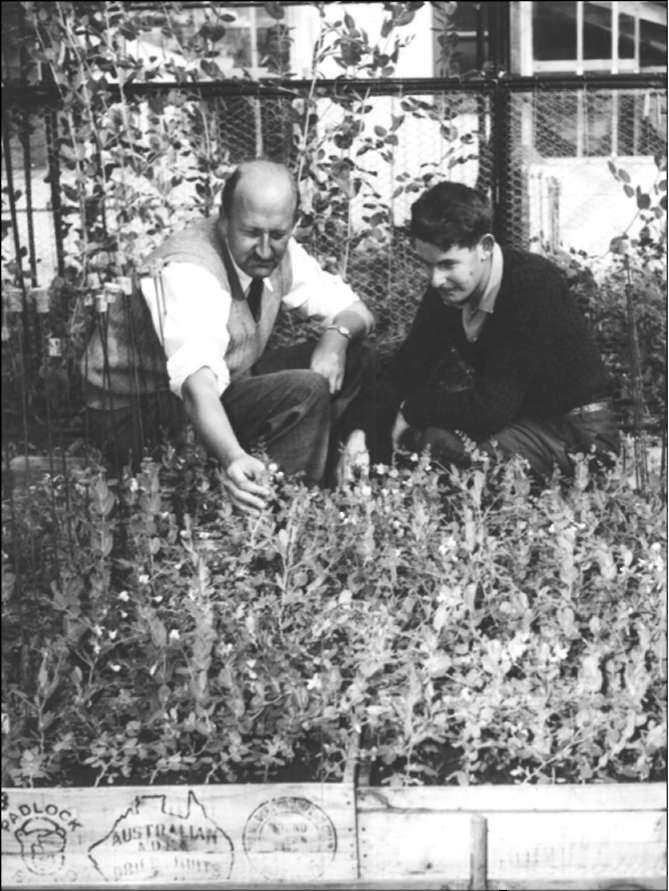Pisum
Genetics
2007ŚVolume
39
PGA Notes
In honor of Ian Murfet
N.F. Weeden for the Coordinating Committee of the Pisum
Genetics Association
One of my final duties as Chair
of the
Coordinating Committee for the Pisum Genetics
Association is the privilege and pleasure of
extending to Professor I.C. Murfet life
membership in this organization. Ian has been an
intrepid supporter and leader in the field of pea
genetics and developmental physiology since he
joined the staff at the University of Tasmania at
Hobart, Australia, in the 1960s. During his
approximately 40-year tenure at UTAS he lived
and contributed to the revolution in pea genetics.
Coordinating Committee for the Pisum Genetics
Association is the privilege and pleasure of
extending to Professor I.C. Murfet life
membership in this organization. Ian has been an
intrepid supporter and leader in the field of pea
genetics and developmental physiology since he
joined the staff at the University of Tasmania at
Hobart, Australia, in the 1960s. During his
approximately 40-year tenure at UTAS he lived
and contributed to the revolution in pea genetics.
In the mid twentieth century, pea
maintained
a position as one of the outstanding models for
classical and physiological genetics. Ian applied
the extensive tools and knowledge available in pea
at that time to unraveling the genetics and
physiology of flowering time, branching habit,
and stem height. Despite receiving his graduate
training before techniques in molecular biology
became widely used, Ian made a smooth transition
into the genomic era, permitting his laboratory to
move from classical genetic analysis to the cloning
and characterization of the sequences responsible
for the observed variation. His program is one of
a position as one of the outstanding models for
classical and physiological genetics. Ian applied
the extensive tools and knowledge available in pea
at that time to unraveling the genetics and
physiology of flowering time, branching habit,
and stem height. Despite receiving his graduate
training before techniques in molecular biology
became widely used, Ian made a smooth transition
into the genomic era, permitting his laboratory to
move from classical genetic analysis to the cloning
and characterization of the sequences responsible
for the observed variation. His program is one of

the few working outside
arabidopsis and rice to
have successfully dissected
important plant
phenotypes into their genetic constituents and
described the interactions of these genes at the
phenotypes into their genetic constituents and
described the interactions of these genes at the
Ian Murfet (right)
discussing pea phenotypes with
Professor Newton Barber earlier in his career at the
University of Tasmania, Hobart, Australia. (Photo
courtesy of School of Plant Science, UTAS).
Professor Newton Barber earlier in his career at the
University of Tasmania, Hobart, Australia. (Photo
courtesy of School of Plant Science, UTAS).
molecular level.
This transition from a classical
to a genomic approach was not without difficulties and
frustrations.
Despite the extensive genetic and physiological studies that had been performed in pea by the 1970s, its
large genome, relative intractability to cultivation in tissue culture or transformation, and status as a
secondary cropŚeven to other legumes such as soybean and common bean, served to eliminate it from
contention as a molecular genetic model during the 80s and 90s. Thus, the progress made in Ian's program
is particularly impressive, and serves to show what ingenuity, creativity and perseverance can do in the
face of significant obstacles and little funding. With the recent progress in the sequencing of the genome
of Medicago truncatula, and the relative ease of going from this genome to that of pea, it is clear that pea
again can be considered a model species for many traits. Certainly, the extensive knowledge now available
on the genetics of flowering in pea (see review by Jim Weller, pp. 1-7), positions pea as the model legume
for this character.
Despite the extensive genetic and physiological studies that had been performed in pea by the 1970s, its
large genome, relative intractability to cultivation in tissue culture or transformation, and status as a
secondary cropŚeven to other legumes such as soybean and common bean, served to eliminate it from
contention as a molecular genetic model during the 80s and 90s. Thus, the progress made in Ian's program
is particularly impressive, and serves to show what ingenuity, creativity and perseverance can do in the
face of significant obstacles and little funding. With the recent progress in the sequencing of the genome
of Medicago truncatula, and the relative ease of going from this genome to that of pea, it is clear that pea
again can be considered a model species for many traits. Certainly, the extensive knowledge now available
on the genetics of flowering in pea (see review by Jim Weller, pp. 1-7), positions pea as the model legume
for this character.
For ten years Ian served as
Editor of Pisum Genetics, giving the journal its present name
and
instituting more rigor in the review of submitted manuscripts so that they could truly be considered peer
reviewed. In addition to his many other contributions to the field, it is for his long service in the Pisum
Genetics Association and for his continual support of young scholars pursuing studies involving pea that
instituting more rigor in the review of submitted manuscripts so that they could truly be considered peer
reviewed. In addition to his many other contributions to the field, it is for his long service in the Pisum
Genetics Association and for his continual support of young scholars pursuing studies involving pea that
iii